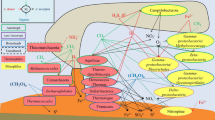Abstract
Microbiological investigation of the highly mineralized, sulfide-rich cold spring of the Ust’-Kachka resort was carried out. The total number and biomass of microbial cells were 50 × 103 cell/mL and 15 μg/L, respectively. While the total microbial number was low, the sulfate reduction rate determined by the radioisotope method was relatively high (0.575 mg S L−1 day−1). An enrichment culture was obtained on Widdel medium. According to the results of cloning the 16S rRNA gene fragments with subsequent restriction analysis, the dominant organisms were group 6 sulfate-reducing bacteria (Desulfovibrio-Desulfomicrobium) and the microorganism exhibiting 99% similarity to the anaerobic haloalkaliphilic bacterium Halanaerobium hydrogeniformans.
Similar content being viewed by others
References
Ghiorse, W.C. and Wilson, J.T., Microbial Ecology of the Terrestrial Subsurface, Adv. Appl. Microbiol., 1988, vol. 33, pp. 107–172.
Pedersen, K., Exploration of Deep Intraterrestrial Life-Current Perspectives, FEMS Microbiol. Lett., 2000, vol. 185, pp. 9–16.
Griebler, C. and Lueders, T., Microbial Biodiversity in Groundwater Ecosystems, Freshwater Biol., 2009, vol. 54, pp. 649–647.
Nazina, T.N. and Belyaev, S.S., Biological and Metabolic Diversity of Microorganism in Oil Fields, in Trudy Instituta Mikrobiologii im. S.N. Vinogradskogo (Proc. Winogradsky Inst. Microbiol.), vol. 12, Gal’chenko, V.F., Ed., Moscow: Nauka, 2004, pp. 289–316.
Pfennig, N. and Lippert, K.D., Uber das Vitamin B12—Bedürfnis Phototropher Schweferelbakterien, Arch. Microbiol., 1966, vol. 55, no. 3, pp. 245–256.
Hungate, R.E., Methods in Microbiology, Norris, J.L. and Ribbons, D.W., Eds., New York: Academic, 1969, vol. 3b, pp. 117–132.
Kompantseva, E.I. and Panteleeva, E.E., Strains of the Halophilic Species Rhodobium marinum That Inhabit Freshwater Hot Springs, Microbiology, 1998, vol. 67, no. 1, pp. 98–104.
Geets, J., Borremans, B., Diels, L., Springael, D., Vangronsveld, J., van der Lelie, D., and Vanbroekhoven, K., DsrB Gene-Based DGGE for Community and Diversity Surveys of Sulfate-Reducing Bacteria, J. Microbiol. Methods, 2006, vol. 66, no. 2, pp. 194–205.
Daly, K., Sharp, R.J., and McCarthy, A.J., Development of Oligonucleotide Probes and PCR Primers for Detecting Phylogenetic Subgroups of Sulfate-Reducing Bacteria, Microbiology (UK), 2000, vol. 146, pp. 1693–1705.
Gounot, A.M., Microbial Ecology of Groundwaters, in Groundwater Ecology, Gibert, J., Danielopol, D.L., and Stanford, J.A., Eds., San Diego: Academic, 1994, pp. 189–215.
Farnleitner, A.H., Wilhartitz, I., Ryzinska, G., Kirschner, A.K.T., Stadler, H., Burtscher, M., Hornek, R., Szewzyk, U., Herndl, G., and March, R.L., Bacterial Dynamics in Spring Water of Alpine Karst Aquifers Indicates the Presence of Stable Autochthonous Microbial Endokarst Communities, Environ. Microbiol., 2005, vol. 7, pp. 1248–1259.
Kallistova, A.Yu., Kevbrina, M.V., Pimenov, N.V., Rusanov, I.I., Rogozin, D.Yu., Verli, B., and Nozhevnikova, A.N., Sulfate Reduction and Methanogenesis in the Shira and Shunet Meromictic Lakes (Khakasia, Russia), Microbiology, 2006, vol. 75, no. 6, pp. 720–726.
Ivanov, M.V., Rusanov, I.I., Pimenov, N.V., Bairamov, I.T., Yusupov, S.K., Savvichev, A.S., Lein, A.Yu., and Sapozhnikov, V.V., Microbial Processes of the Carbon and Sulfur Cycles in Lake Mogil’noe, Microbiology, 2001, vol. 70, no. 5, pp. 583–593.
Brown, S.D., Begemann, M.B., Mormile, M.R., Wall, J.D., Han, C.S., Goodwin, L.A., Pitluck, S., Land, M.L., Hauser, J., and Elias, D.A., Complete Genome Sequence of the Haloalkaliphilic, Hydrogen-Producing Bacterium Halanaerobium hydrogeniformans, J. Bacteriol., 2011, vol. 193, no. 14, pp. 3682–3683.
Rozanova, E.P. and Nazina, T.N., A Mesophilic, Rod-Shaped, Asporogenic Sulfate-Reducing Bacterium, Mikrobiologiya, 1976, vol. 45, no. 5, pp. 825–830.
Rozanova, E.P., Nazina, T.N., and Galushko, A.S., Isolation of a New Genus of Sulfate-Reducing Bacteria and Description of the New Species of This Genus, Desulfomicrobium apsheronum gen. nov., sp. nov., Mikrobiologiya, 1988, vol. 57, no. 4, pp. 634–641.
Gogotova, G.I. and Vainshtein, M.B., Description of Desulfobacterium macestii sp. nov., a New Sulfate-Reducing Bacterium Capable of Autotrophic Growth, Mikrobiologiya, 1989, vol. 58, no. 4, pp. 64–68.
Author information
Authors and Affiliations
Corresponding author
Additional information
Original Russian Text © N.V. Pimenov, G.V. Kuranov, A.L. Bryukhanov, E.F. Veslopolova, I.P. Koryukina, Yu.N. Maslov, 2012, published in Mikrobiologiya, 2012, Vol. 81, No. 6, pp. 779–785.
Rights and permissions
About this article
Cite this article
Pimenov, N.V., Kuranov, G.V., Bryukhanov, A.L. et al. The sulfate-reducing bacterial community of sulfide-rich water of the Ust’-Kachka resort spring, Perm Krai, Russia. Microbiology 81, 721–726 (2012). https://doi.org/10.1134/S0026261712060112
Received:
Published:
Issue Date:
DOI: https://doi.org/10.1134/S0026261712060112




